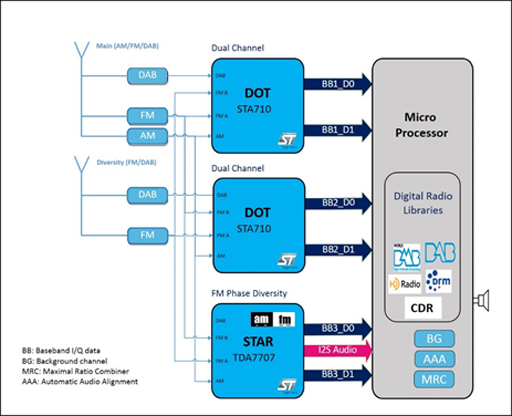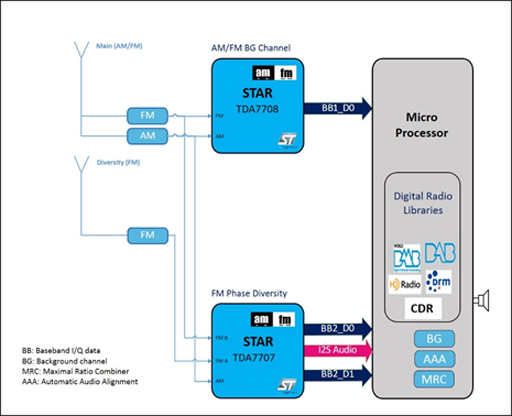By Marco Carbone, Director — Radio Products, STMicroelectronics
The concept of software-defined radio (SDR) has been around for many years, but only recently have automotive manufacturers identified the components that make the implementation of an SDR receiver competitive in terms of cost and performance.
Let’s look at the challenges: A modern automotive radio receiver must handle both analog AM/FM reception, as analog standards have been and will be around for a long time, and the upcoming digital standards, including HD Radio in the U.S., Digital Audio Broadcasting (DAB) in Europe, DRM in India, and CDR in China.

An up-to-date receiver must support the simultaneous reception of multiple broadcast channels and incorporate sophisticated DSP algorithms for optimal performance. As of today, SDR is probably the best approach to achieve the flexibility and the re-configurability needed by mid- to high-class car radio receivers.
Classification of SDR
According to the most recent trends in the infotainment market, two categories of SDR are emerging: hybrid software-defined radio (H-SDR) and full software-defined radio (F-SDR).
The two SDR flavors utilize three basic components:
- Standalone radio tuners: single-chip receivers including a multi-band RF section, a high-dynamic-range analog-to-digital (A/D) conversion stage, and the complete AM/FM processing to the audio output
- RF2bit tuners: tuners that share the same RF and ADC sections of the standalone tuner, a subset of the signal processing logic limited to some filtering and decimation, and a serial output interface optimized in terms of noise performance
- Standard or custom multi-core microprocessors: processors designed to handle entertainment and informative applications in automobiles or specifically dedicated to run broadcast radio services
In the H-SDR implementation, the AM/FM demodulation and the signal processing are performed inside a standalone tuner while all the digital services (for instance, DAB, HD Radio, and others) libraries are executed by a microprocessor. Considering that SDR very often implies multi-channel solutions, the RF section of H-SDR is a combination of RF2bit and standalone tuners.
In the F-SDR implementation, all radio software libraries — both analog AM/FM and digital services — run on the microprocessor. The F-SDR approach requires only a combination of RF2bit tuners feeding the microprocessor. These RF2bit tuners provide digitized IF I/Q data to the processor in charge of decoding the desired broadcast services.
In both H-SDR and F-SDR architectures, the microprocessor can be a standard “off-the-shelf” component or a custom SDR processor. Not only does the processor’s task include executing the radio libraries but it must also perform the algorithms that improve the user experience — audio stream alignment, service linking, and seamless switching for a smooth transition between AM/FM and digital broadcast services.
The presence of one or more DSP cores helps optimize the execution of the complex algorithmic calculations, but it is not strictly mandatory; many modern processors may rely on single-instruction multiple-data (SIMD) architecture extensions to accelerate signal processing tasks.
A good SDR solution should assure world-class performance and increased flexibility without a significant impact on the system cost. For this reason, the implementation of multi-channel solutions must rely on the utilization of a single crystal oscillator for all the tuners.
Another critical aspect is the optimization of the signal transmission from the tuners to the microprocessor. Single-ended serial interfaces are the easiest connection to standard microprocessors, but the adoption of low-voltage differential signaling (LVDS) interfaces can contribute to improved system performance.
An example of last-generation standalone and RF2bit tuners are STMicroelectronics’ STAR (STAR — ST Advanced Radio (STAR) tuner and Digital Output Tuner (DOT) families .
The new product families specifically take into account the most recent SDR trends. All versions, including single- and dual-radio channel devices, are available in pin-to-pin compatible packages for an easy switch from H-SDR to F-SDR.
Fig. 1 shows the high-level diagram of an H-SDR solution implementing a multi-channel radio receiver architecture aimed at the European market.

The receiver can support the following use cases:
Analog processing
- FM Phase Diversity (PD) + FM/AM Background + TMC
Digital processing
- DAB Main Channel (also includes audio source decoding) combined via MRC + DAB Background + TPEG
- DAB-DAB & DAB-FM Service linking
- DAB-FM & FM-DAB Audio correlation (seamless switching)
Fig. 2 shows the high-level diagram of an H-SDR solution implementing a multi-channel radio receiver architecture aimed at the U.S. market.

The number of RF devices is lower thanks to the in-band-on-channel approach of HD Radio; on top of the AM/FM configuration described above, HD MRC and HD Background are supported.
The performance of the solution and scalability of the receiver, which can be easily downgraded or upgraded by modifying the number of RF components and the software configuration of the processor, are advantages of this SDR implementation.
Today, it may be difficult to assess which of the two approaches, H-SDR or F-SDR, is more convenient. F-SDR can be the ultimate solution but considering how challenging it is to implement a good AM/FM solution in a noisy microprocessor environment, H-SDR may carve out a significant space in the market for many years to come.
Advertisement
Learn more about STMicroelectronics





